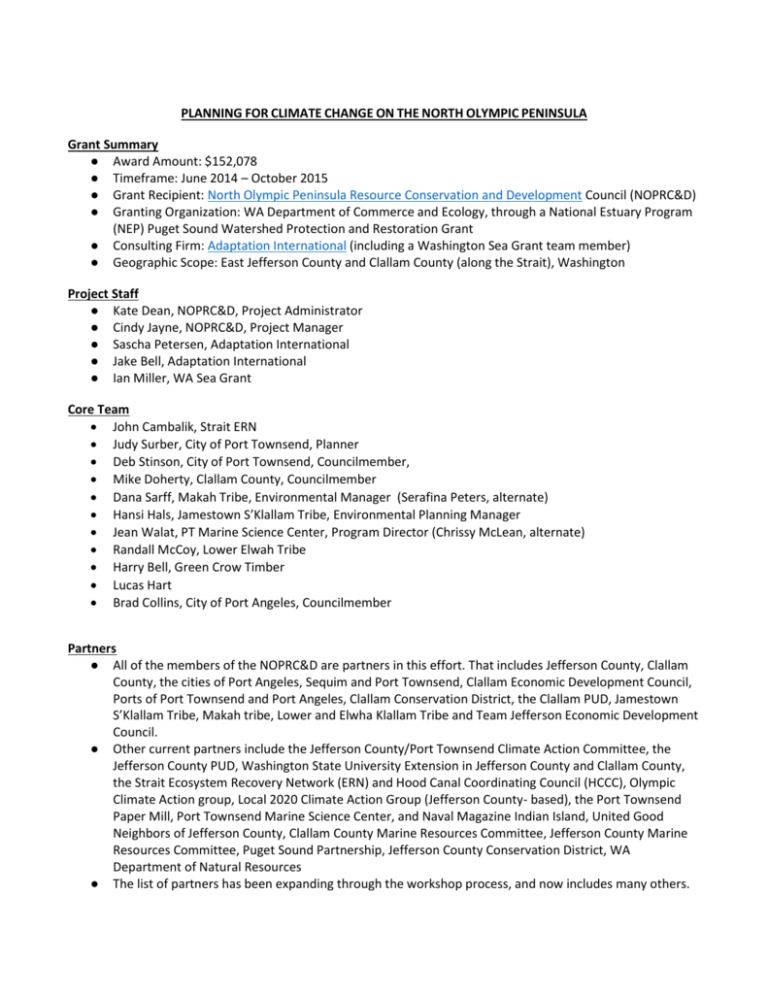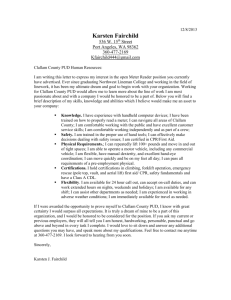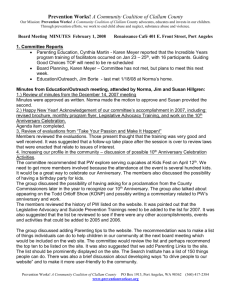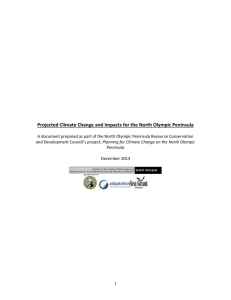Planning for Climate Change on the North Olympic Peninsula
advertisement

PLANNING FOR CLIMATE CHANGE ON THE NORTH OLYMPIC PENINSULA Grant Summary ● Award Amount: $152,078 ● Timeframe: June 2014 – October 2015 ● Grant Recipient: North Olympic Peninsula Resource Conservation and Development Council (NOPRC&D) ● Granting Organization: WA Department of Commerce and Ecology, through a National Estuary Program (NEP) Puget Sound Watershed Protection and Restoration Grant ● Consulting Firm: Adaptation International (including a Washington Sea Grant team member) ● Geographic Scope: East Jefferson County and Clallam County (along the Strait), Washington Project Staff ● Kate Dean, NOPRC&D, Project Administrator ● Cindy Jayne, NOPRC&D, Project Manager ● Sascha Petersen, Adaptation International ● Jake Bell, Adaptation International ● Ian Miller, WA Sea Grant Core Team John Cambalik, Strait ERN Judy Surber, City of Port Townsend, Planner Deb Stinson, City of Port Townsend, Councilmember, Mike Doherty, Clallam County, Councilmember Dana Sarff, Makah Tribe, Environmental Manager (Serafina Peters, alternate) Hansi Hals, Jamestown S’Klallam Tribe, Environmental Planning Manager Jean Walat, PT Marine Science Center, Program Director (Chrissy McLean, alternate) Randall McCoy, Lower Elwah Tribe Harry Bell, Green Crow Timber Lucas Hart Brad Collins, City of Port Angeles, Councilmember Partners ● All of the members of the NOPRC&D are partners in this effort. That includes Jefferson County, Clallam County, the cities of Port Angeles, Sequim and Port Townsend, Clallam Economic Development Council, Ports of Port Townsend and Port Angeles, Clallam Conservation District, the Clallam PUD, Jamestown S’Klallam Tribe, Makah tribe, Lower and Elwha Klallam Tribe and Team Jefferson Economic Development Council. ● Other current partners include the Jefferson County/Port Townsend Climate Action Committee, the Jefferson County PUD, Washington State University Extension in Jefferson County and Clallam County, the Strait Ecosystem Recovery Network (ERN) and Hood Canal Coordinating Council (HCCC), Olympic Climate Action group, Local 2020 Climate Action Group (Jefferson County- based), the Port Townsend Paper Mill, Port Townsend Marine Science Center, and Naval Magazine Indian Island, United Good Neighbors of Jefferson County, Clallam County Marine Resources Committee, Jefferson County Marine Resources Committee, Puget Sound Partnership, Jefferson County Conservation District, WA Department of Natural Resources ● The list of partners has been expanding through the workshop process, and now includes many others. Background Climate change poses a variety of threats (or pressures) to the North Olympic Peninsula (NOP), specifically Jefferson and Clallam County, WA. Climate change on the NOP has the potential to increase air temperatures, change precipitation patterns, reduce snowpack, and alter the biochemical cycle of the forests and oceans. These changes may result in a number of impacts, such as: ● Sea level rise and an increased risk of coastal flooding; ● Increases in peak flows in the streams and river as well as lower summer stream flows; ● An increased risk of summer water shortages; ● Reduction in the health of forests and an increase in forest fires; and ● Increased challenges for the fish, wildlife, and people who depend on the NOP For East Jefferson and Clallam County, we have an opportunity to reduce the risks due to climate change through the detailed assessment of climate related vulnerabilities and the creation of a Climate Preparedness Plan for the NOP. This plan will inform the comprehensive and strategic planning processes of the cities, counties, tribes, Public Utility Districts, and ports within the NOP. The plan will include: ● A compilation of detailed local observations and projections of climate change using best available science; ● A prioritization of highly sensitive or vulnerable resources and locations; ● A prioritized set of adaptation strategies and actions based on both the science and the knowledge of local stakeholders; The information and strategies of this Climate Preparedness Plan, as well as the discussions and information sharing that are part of the development of the plan, will then be input to current and future comprehensive and strategic planning efforts of the cities, counties, ports, and tribes. Project Steps and Timeline The basic steps and timeline of the project are: 1. Conduct a high level climate assessment that summarizes the observed trends and projected changes in the climate for the NOP (changes in precipitation, air and water temperatures, etc.) and the projected impacts of climate change on the NOP. (June 2014 – October 2014) (COMPLETED AUGUST 2014) 2. Use research, interviews, and workshops to conduct a prioritized risk assessment of climate change for the NOP by conducting a vulnerability assessment of the NOP based on: 1) how the climate is changing; 2) how sensitive key sectors, resources, or areas are to those changes; and 3) the ability of our systems and environment to adapt to those changes. (Nov 2014 – Feb 2015) (COMPLETED NOV 2014) 3. Develop potential solutions and actions for reducing risk and increasing resilience for the prioritized higher risk areas through research and workshops with local experts. Write the Climate Preparedness Plan for the North Olympic Peninsula and create outreach materials, and present it to municipalities (including Planning Commissions), watershed planning organizations, and other groups in Jefferson and Clallam Counties, to inform their decision-making with specific local information and strategies to reduce the risks due to the potential impacts of climate change. (March 2015 – Sept 2015) 4. Track the implementation of solutions and actions recommended in the Climate Preparedness Plan. (Sept 2015 – ongoing)











